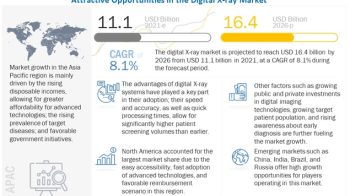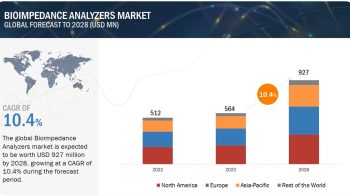According to a new market research report “Optical Imaging Market (2013-2018) – Technology Trends And Applications Of Optical Coherence Tomography (OCT), Hyper Spectral Imaging (HSI), Near Infrared Spectroscopy (NIRS) And Photo- Acoustic Tomography (PAT) In Clinical Diagnostics, Clinical Research And Life Sciences With Market Landscape Analysis – Estimates Up To 2018 ” ,published by MarketsandMarkets the value of Optical Imaging Technologies Market was $915.75 Million in the year 2012 and is expected to reach $1.9 Billion by 2018, at an estimated CAGR of 11.37% from 2013 to 2018.
Browse >>
- 10 market data tables
- 36 figures/Charts
- 147 slides
Early buyers will receive 10% customization on this report.
The global healthcare industry is witnessing a shift in paradigm and is now skewed towards non-invasive diagnostics and therapeutic procedures, which not only cures serious illnesses, but also have fewer side effects. Optical imaging is one such technology with a potential to revolutionize clinical diagnostics and drug discovery in healthcare. The technology uses light to assess optical properties of tissues, and have a great potential in the diagnosis and treatment of chronic diseases.
Though optical imaging is still in the early phase of development, it offers a number of important advantages over existing radiological imaging techniques. Optical imaging procedures are non-invasive, uses no ionizing radiation and offer significant cost savings than the conventional radiological technologies. These technologies have an inherent capacity for improving diagnostic resolution. A key driving force of Optical imaging techniques is the technology application scope for easy access to visualize and image in-depth structures of eye, surface tissues, mucosal membranes, the gastrointestinal tract, and vascular systems facilitating better diagnostic procedures in clinical medicine. They also enhance the drug discovery process by enabling better imaging of tissues and other biological entities at the molecular level in biomedical research. The other advantages of using optical imaging include the technologies are operator and patient safety. In the future, most of these technologies will gain widespread clinical acceptance and find specific roles in the clinical medicine.
This research service classifies optical Imaging technologies into Optical Coherence Tomography (OCT), Photo-Acoustic Tomography (PAT), Hyperspectral Imaging (HSI) and Near-Infrared Spectroscopy (NIRS). These technologies are expected to drive the global optical imaging market for the coming five years.
Currently, the market of optical imaging is dominated by OCT with over 70% of the market share and is expected to witness 4% CAGR growth by the end of 2018. OCT is widely accepted for clinical diagnostics in ophthalmology, dentistry, cardiology, dermatology and also has broadened its application in cancer detection recently. Carl Zeiss and St. Jude Medical are the pioneers of this technology and almost every set up comes with OCT technology. HSI, NIRS and PAT are the emerging technologies in optical imaging market with a few players in the market. HSI and NIRS are currently used for biomedical research and drug discovery in the areas of dermatology and neurology. These technologies are expected to grow exponentially, with a few units now readily available in the market. Another emerging technology which recently made its entry into market for cancer detection is the photo acoustic tomography (PAT). Recent advances in PAT have made it possible to enhance its ability in recovering both optical and acoustic properties that adds to its potential to better differentiate benign from malignant lesions.
The global optical imaging market is poised to grow at a CAGR of 11.37% from the year 2012 reaching approximately $1.9 billion by 2018. America is the major market for optical imaging equipments followed by Europe and they have been driving the market significantly owing to rising aging population in these regions. Emerging economies such as Asia-pacific and Middle-East are the future drivers of this market.
The main set-back of optical imaging market is lack of reimbursement coverage. However, reimbursement policies would likely improve once these technologies become more available.
The technology report identifies the potential market drivers and restraints for analyzing the future technology trends, opportunities and overcoming the challenges. The market segmentation, sizing and forecasts were made only for the OCT technology and revenues are forecasted on the basis of major regions such as North America and Europe Union. Further, the market is sub-segmented based on OCT applications in clinical diagnostics – ophthalmology, dentistry, dermatology, cardiology, neurology and oncology, clinical research- biomedical research, drug discovery and therapeutic delivery, and life sciences- small animal imaging and revenues were forecasted for the same.
The key players profiled in the report are Michelson Diagnostics, Heidelberg Engineering GmBH, Carl Zeiss Meditec, Volcano Corporation, Topcon Medical Systems Inc., St. Jude Medical Inc., Headwall Photonics, Cytoviva Inc., ChemImage Corporation, Bioptigen Inc., Raytheon ELCAN Optical Technologies, Somanetics Corporation and ASE Optics Inc.
We at MarketsandMarkets are inspired to help our clients grow by providing apt business insight with our huge market intelligence repository.
Contact:
Mr. Rohan
North – Dominion Plaza,
17304 Preston Road,
Suite 800, Dallas, TX 75252
Tel: +1-888-6006-441
Email: sales@marketsandmarkets.com
LinkedIn Company Page @ http://www.linkedin.com/company/marketsandmarkets
Google plus Profile @ https://plus.google.com/u/0/b/113935125281262465077/113935125281262465077/posts




